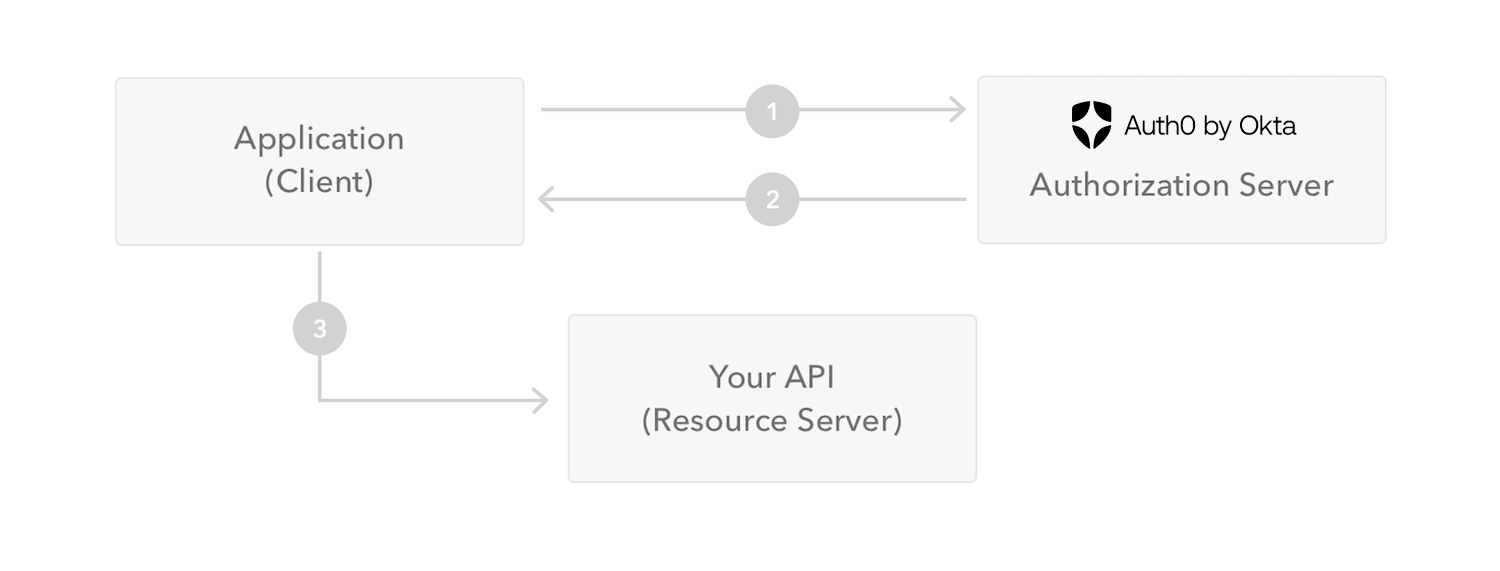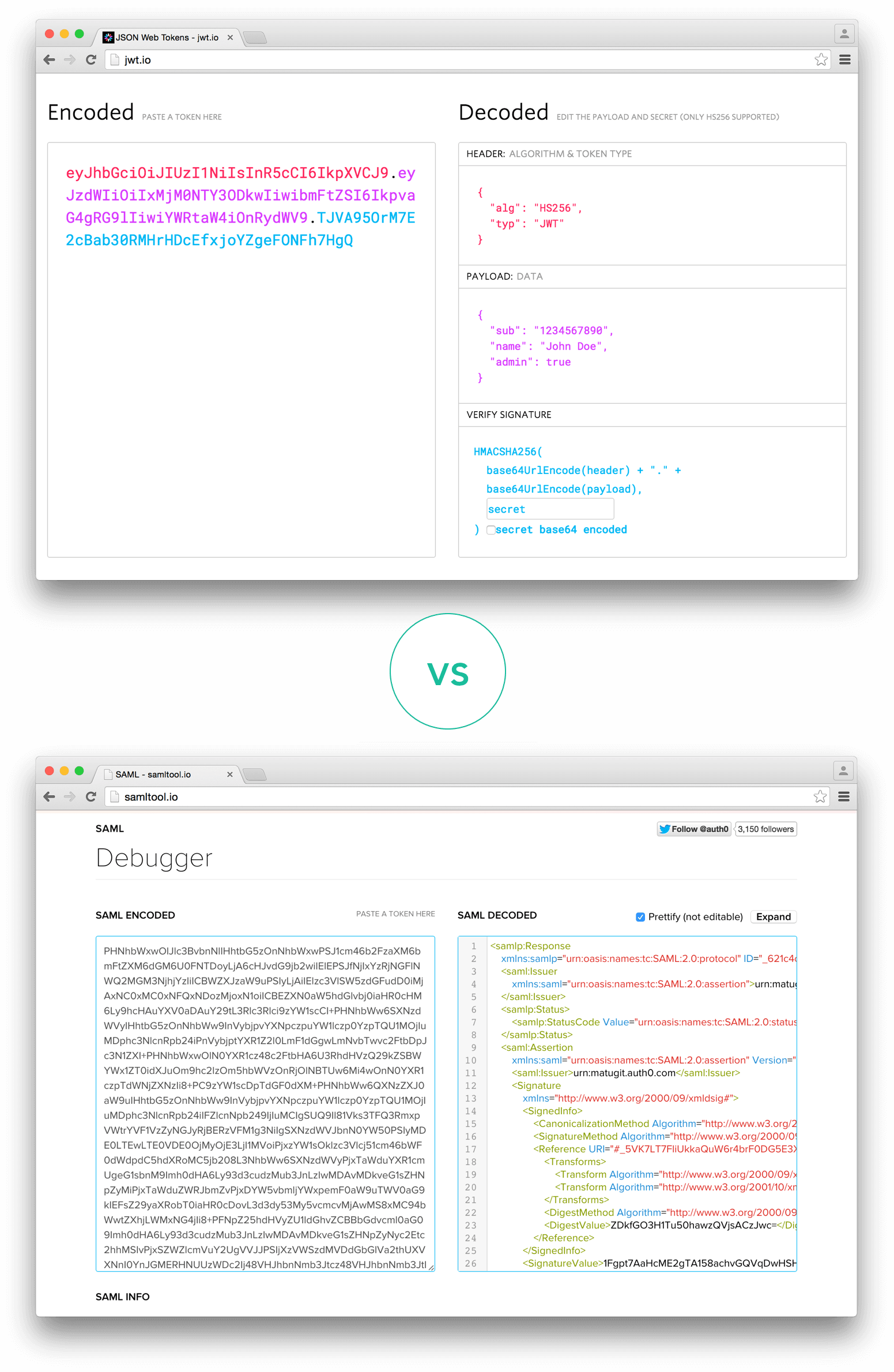NEW:
get the
JWT Handbook for free
and learn JWTs in depth!
What is JSON Web Token?
JSON Web Token (JWT) is an open standard (
RFC 7519
) that defines a compact and self-contained way for securely transmitting information between parties as a JSON object. This information can be verified and trusted because it is digitally signed. JWTs can be signed using a secret (with the
HMAC
algorithm) or a public/private key pair using
RSA
or
ECDSA
.
Although JWTs can be encrypted to also provide secrecy between parties, we will focus on
signed
tokens. Signed tokens can verify the
integrity
of the claims contained within it, while encrypted tokens
hide
those claims from other parties. When tokens are signed using public/private key pairs, the signature also certifies that only the party holding the private key is the one that signed it.
When should you use JSON Web Tokens?
Here are some scenarios where JSON Web Tokens are useful:
-
Authorization
: This is the most common scenario for using JWT. Once the user is logged in, each subsequent request will include the JWT, allowing the user to access routes, services, and resources that are permitted with that token. Single Sign On is a feature that widely uses JWT nowadays, because of its small overhead and its ability to be easily used across different domains.
-
Information Exchange
: JSON Web Tokens are a good way of securely transmitting information between parties. Because JWTs can be signed?for example, using public/private key pairs?you can be sure the senders are who they say they are. Additionally, as the signature is calculated using the header and the payload, you can also verify that the content hasn't been tampered with.
What is the JSON Web Token structure?
In its compact form, JSON Web Tokens consist of three parts separated by dots (
.
), which are:
Therefore, a JWT typically looks like the following.
xxxxx.yyyyy.zzzzz
Let's break down the different parts.
Header
The header
typically
consists of two parts: the type of the token, which is JWT, and the signing algorithm being used, such as HMAC SHA256 or RSA.
For example:
{
"alg": "HS256",
"typ": "JWT"
}
Then, this JSON is
Base64Url
encoded to form the first part of the JWT.
Payload
The second part of the token is the payload, which contains the claims. Claims are statements about an entity (typically, the user) and additional data.
There are three types of claims:
registered
,
public
, and
private
claims.
-
Registered claims
: These are a set of predefined claims which are not mandatory but recommended, to provide a set of useful, interoperable claims. Some of them are:
iss
(issuer),
exp
(expiration time),
sub
(subject),
aud
(audience), and
others
.
Notice that the claim names are only three characters long as JWT is meant to be compact.
-
Public claims
: These can be defined at will by those using JWTs. But to avoid collisions they should be defined in the
IANA JSON Web Token Registry
or be defined as a URI that contains a collision resistant namespace.
-
Private claims
: These are the custom claims created to share information between parties that agree on using them and are neither
registered
or
public
claims.
An example payload could be:
{
"sub": "1234567890",
"name": "John Doe",
"admin": true
}
The payload is then
Base64Url
encoded to form the second part of the JSON Web Token.
Do note that for signed tokens this information, though protected against tampering, is readable by anyone. Do not put secret information in the payload or header elements of a JWT unless it is encrypted.
Signature
To create the signature part you have to take the encoded header, the encoded payload, a secret, the algorithm specified in the header, and sign that.
For example if you want to use the HMAC SHA256 algorithm, the signature will be created in the following way:
HMACSHA256(
base64UrlEncode(header) + "." +
base64UrlEncode(payload),
secret)
The signature is used to verify the message wasn't changed along the way, and, in the case of tokens signed with a private key, it can also verify that the sender of the JWT is who it says it is.
Putting all together
The output is three Base64-URL strings separated by dots that can be easily passed in HTML and HTTP environments, while being more compact when compared to XML-based standards such as SAML.
The following shows a JWT that has the previous header and payload encoded, and it is signed with a secret.

If you want to play with JWT and put these concepts into practice, you can use
jwt.io Debugger
to decode, verify, and generate JWTs.

How do JSON Web Tokens work?
In authentication, when the user successfully logs in using their credentials, a JSON Web Token will be returned. Since tokens are credentials, great care must be taken to prevent security issues. In general, you should not keep tokens longer than required.
You also
should not store sensitive session data in browser storage due to lack of security
.
Whenever the user wants to access a protected route or resource, the user agent should send the JWT, typically in the
Authorization
header using the
Bearer
schema. The content of the header should look like the following:
Authorization: Bearer <token>
This can be, in certain cases, a stateless authorization mechanism. The server's protected routes will check for a valid JWT in the
Authorization
header, and if it's present, the user will be allowed to access protected resources. If the JWT contains the necessary data, the need to query the database for certain operations may be reduced, though this may not always be the case.
Note that if you send JWT tokens through HTTP headers, you should try to prevent them from getting too big. Some servers don't accept more than 8 KB in headers. If you are trying to embed too much information in a JWT token, like by including all the user's permissions, you may need an alternative solution, like
Auth0 Fine-Grained Authorization
.
If the token is sent in the
Authorization
header, Cross-Origin Resource Sharing (CORS) won't be an issue as it doesn't use cookies.
The following diagram shows how a JWT is obtained and used to access APIs or resources:

- The application or client requests authorization to the authorization server. This is performed through one of the different authorization flows. For example, a typical
OpenID Connect
compliant web application will go through the
/oauth/authorize
endpoint using the
authorization code flow
.
- When the authorization is granted, the authorization server returns an access token to the application.
- The application uses the access token to access a protected resource (like an API).
Do note that with signed tokens, all the information contained within the token is exposed to users or other parties, even though they are unable to change it. This means you should not put secret information within the token.
Why should we use JSON Web Tokens?
Let's talk about the benefits of
JSON Web Tokens (JWT)
when compared to
Simple Web Tokens (SWT)
and
Security Assertion Markup Language Tokens (SAML)
.
As JSON is less verbose than XML, when it is encoded its size is also smaller, making JWT more compact than SAML. This makes JWT a good choice to be passed in HTML and HTTP environments.
Security-wise, SWT can only be symmetrically signed by a shared secret using the HMAC algorithm. However, JWT and SAML tokens can use a public/private key pair in the form of a X.509 certificate for signing. Signing XML with XML Digital Signature without introducing obscure security holes is very difficult when compared to the simplicity of signing JSON.
JSON parsers are common in most programming languages because they map directly to objects. Conversely, XML doesn't have a natural document-to-object mapping. This makes it easier to work with JWT than SAML assertions.
Regarding usage, JWT is used at Internet scale. This highlights the ease of client-side processing of the JSON Web token on multiple platforms, especially mobile.
 Comparison of the length of an encoded JWT and an encoded SAML
Comparison of the length of an encoded JWT and an encoded SAML
If you want to read more about JSON Web Tokens and even start using them to perform authentication in your own applications, browse to the
JSON Web Token landing page
at Auth0 by Okta.